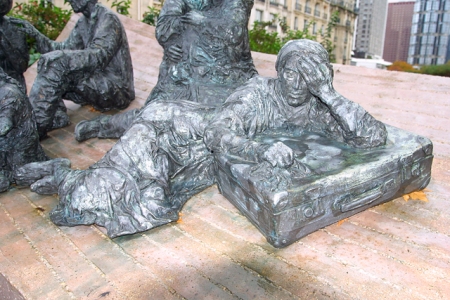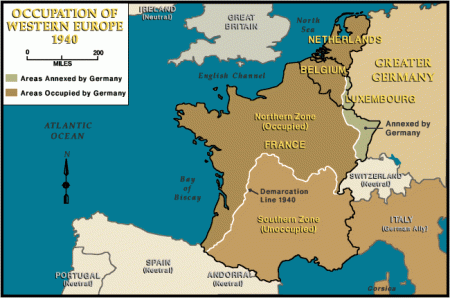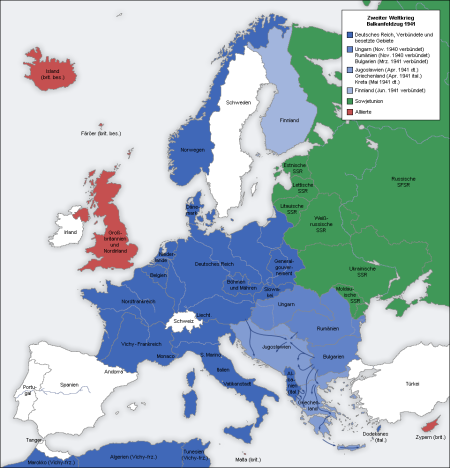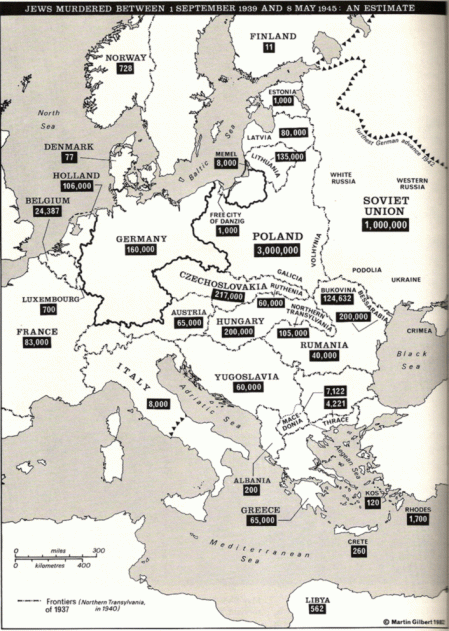A beautiful little girl rose up from the ashes of the Holocaust, but she was far removed from the elderly survivor who told her story in the first person. Eva says that through more than 100 speeches and interviews she always felt like she was “looking down at this little girl and telling her story.” That all changed in late 1985, when at the age of 51, she was lecturing at Indiana State University. “I was describing my separation from my mother, and I began to sob and sob. I was very confused, troubled and embarrassed because I did not have a handkerchief. I had never needed one before. I cried because I could feel all the pain, fear and horror that I had felt at Auschwitz. I never again ended my lecture by saying that I was telling the story of that little girl. That little girl and I became one. I had suddenly found the child that had been lost at Auschwitz.”

Miriam and Eva Mozes
Though Eva says she found the lost little girl who survived Auschwitz, the horror she suffered there left her without a childhood. In her autobiography Echoes From Auschwitz: Dr. Mengele’s Twins, The Story of Eva and Miriam Mozes, she blames the death camp for stealing her childhood. “Children who are faced with life and death so abruptly are no longer children.” This became abundantly clear to 11-year-old Eva who found herself after World War II in a Polish monastery with other liberated children. “The nuns had put beautiful toys in our rooms, but I didn’t want to play with them. I wasn’t in any way impressed or thrilled to find toys to play with…I had lost my childhood.”
Eva Mozes Kor was one of about 200 child survivors of the Auschwitz-Birkenau death camp. She and twin sister Miriam were spared the gas chambers by an SS guard who asked Mrs. Mozes, “Zwilling?!”(Twins?!), only to end up in the hands of “the Angel of Death,” Dr. Josef Mengele who performed sadistic experiments on them. The experiments nearly took Eva’s life while in the camp, and ultimately did take Miriam’s life in 1993. Eva dedicated the book, in part, to her sister Miriam who suffered kidney problems her entire life and died in Israel from “cancer related to the experiments.”
The first seven chapters of Echoes cover Eva’s memories of Portz, a rural farming village in the Transylvania region of Rumania. The Mozes’ were prominent landowners and had “the only Jewish house in the village.” Eva and Miriam were the youngest of four children born to a religious, hard-working father and a benevolent, educated mother. Out-of-town guests always had a room at the Mozes home and “any villager who ever had a problem or needed advice always came to [Eva’s] mother.” As she puts it, “Life was very simple for us in this rural area of Transylvania.” But that would all soon change in 1940.
In Chapter 8, Eva describes the changing environment of her village under Hungarian occupation. “Rumanians and Hungarians hated each other,” Eva says and that’s why she was particularly alarmed by the sudden change. As both Rumanian and Jewish, her family had twice the reason to be worried. “After the Hungarian Army took charge,” she writes, “[t]he beginning of the end was upon us.”
Eva and Miriam were brought face-to-face with the vitriolic Nazi propaganda at school. “The first time I ever saw what we called ‘jumping pictures on the wall,’ it dealt only with one topic: how to harass, intimidate and kill a Jew.” Eva ran home crying, hoping her mother could “explain the horrible things” she had seen. Her parents had heard the terrible rumors about what was happening in Eastern Europe. They listened intently to reports coming in over the radio, but attempted to shield the children by speaking about it only in Yiddish. Eva resented their secrecy and later blamed them for not taking the rumors and news reports more seriously.
Chapter 10 begins in 1943 with the Mozes family under house arrest and forced to wear the Star of David. “Yellow to indicate what cowards the Jews were,” Eva explains.
Next came deportation to the Szilagysomlyo ghetto near Simleul Silvanei. Eva couldn’t believe that only two Hungarian gendarmes were able to arrest her family of six while the entire village watched, as if helpless to defend them. She writes, “…it would have been so easy to overpower them…Nobody even tried. No one said even a word that they were sorry.” The silent onlookers had been their friends, their neighbors, “the people who had helped us farm and had benefited from our harvest…the boys and girls with whom we had gone to school.”
The Mozes family lived in tents along with 7,000 – 8,500 ghettoized Jews for five weeks before final deportation. They were among the 437,000 Hungarian Jews deported to death camps in mid-1944, a fact supported by Randolph L. Braham in his book The politics of genocide: the Holocaust in Hungaria (Wayne State University Press, Detroit, 2000, ISBN 0814326919, p. 137). Braham confirms that May – June 1944 almost 300,000 Jews had been deported, beginning with those in Northern Transylvania. After being herded onto cattle cars with 70-100 other people marked for death, the Mozes family made the 70-hour journey to Auschwitz II with no food and very little water.
Before the door to the cramped, foul-smelling cattle car was opened, Eva remembers her father saying his morning prayers. She also recalls her anger. “As I watched my father and the other people in our car praying to God, a strange feeling of anger swept over me. It was an anger that I had experienced…when we had been called ‘Dirty Jews’…[and] that day when the Hungarian gendarmes were taking us away to the ghetto and no one spoke up or tried to help us, not even my friend Luci.” The feeling of anger was soon replaced by anxiety and despair as Eva and her twin sister were separated from their family, never to see them again. “I remember crying when we were grabbed away from our mother, but I do not remember crying any more after that.”

Dr. Josef Mengele
The twins were soon “processed,” each bearing blue tattoos with the labels “A 7063” for Eva and “A 7064” for Miriam. As far as the Nazis were concerned, they no longer had names. Their only purpose was to serve as Dr. Mengele’s “precious guinea pigs.” Under tight SS surveillance, they were then marched to their barracks. Eva opens Chapter 14 with a gruesome story of an anguished mother who reached out for the children and was subdued and brutally murdered by German shepherd guard dogs. She witnessed this and many other horrors on a daily basis while interred at the death camp. “I tried to take it in,” she says, “and I tried to make some sense of it all. But, one cannot make sense out of senselessness.”
The children’s barracks provided the education that caused Eva to “mature very quickly.” She would soon discover the fate of those who were separated on the train platforms, unfit to work for the Nazis and whisked away quickly. Once again, her anger got the better of her and she cried out belligerently to the other twins, “That is ridiculous. We are children. We cannot work, but we are alive…We are not being burned.” She looked up and examined the fiery glow of the furnaces above the chimneys where smoke poured out in continuous, billowed columns and she was at once convinced.
Chapters 14-16 describe camp conditions at Auschwitz-Birkenau, of how the children survived through inhumane experiments and of the pervasive death that hovered over the camp like the ash-gray smoke. Early on, Eva stumbled upon three corpses of children on the latrine floor and the shocking sight steeled her resolve. She determined to survive and keep her sister alive, too. “Death meant ending up on that dirty bathroom floor like a piece of meat…but death was not something I would encounter. This will was so strong in me that even later, when I became ill, I was able…to survive”(emphasis mine).
Chapter 18 describes her illness after being injected with unknown germs by Dr. Mengele and his “medical” staff. Eva tried desperately to hide the extent of her illness in order to spare her life and that of her sister. After two weeks of knocking on death’s door, her will to live triumphed and she slowly recovered. As other sick children were being taken to the gas chamber, she convinced the nurse that she was recovering quicker than she actually was, a feat accomplished by manipulating the thermometer. Soon she was reunited with her sister. “I know today that would I have died, Miriam would have been taken immediately to the lab and killed…Then comparative autopsies comparing my diseased organs to Miriam’s healthy organs would have been done.” She would later learn just how damaged Miriam’s organs actually were.
 The final chapters tell of the hope brought by Allied bombing runs where prisoners could see the planes overhead; the liquidation of the Gypsy camp into which the children were moved, presumably for gassing; the termination of gassing operations in October 1944; and finally of liberation by the Russian Army. Eva and Miriam are the twins at the head of the line in the now famous liberation footage of 27 January 1945.
The final chapters tell of the hope brought by Allied bombing runs where prisoners could see the planes overhead; the liquidation of the Gypsy camp into which the children were moved, presumably for gassing; the termination of gassing operations in October 1944; and finally of liberation by the Russian Army. Eva and Miriam are the twins at the head of the line in the now famous liberation footage of 27 January 1945.
Following liberation, the Mozes twins now orphaned were transferred to a monastery in Katowice, Poland. The Csenghery twins who had survived with their mother and were friends of Eva and Miriam were in a nearby displaced persons (DP) camp. The girls convinced Mrs. Csenghery to pose as their aunt and care for them, to which she agreed. Together they traveled to the Czernowitz DP Camp and then to a camp near Minsk. By September 1945, they had returned to the familiar surroundings of Simleul Silvanei. Eva recalls their return to the village of Portz when she “suddenly realized that [she and Miriam] were all that was left of the Mozes family.”
Reunited with their Aunt Iren who had also survived a camp, the girls stayed with her in Communist Rumania until 1950 when they were able to get visas and travel to Israel. Once in Haifa, they reunited with other beloved family members who had escaped Nazi-occupied Europe. The book ends with Eva’s enlistment in the Israeli Army in 1952.
Eight years later, she married an American, also a survivor, moved with him to the States and mothered two children. They settled in Terre Haute, Indiana, where Eva founded the CANDLES Organization and a Holocaust memorial museum. That is where I met her in January of this year.
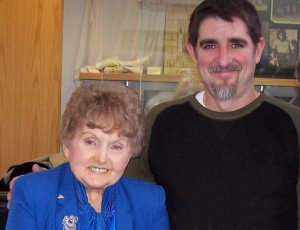
Eva Mozes Kor and Chris Doyle, Jan 2009
Bibliographical Record (from the Library of Congress):
|
LCCN Permalink:
|
http://lccn.loc.gov/95068133 |
|
Type of Material:
|
Book |
|
Personal Name:
|
Kor, Eva Mozes. |
|
Main Title:
|
Echoes from Auschwitz : Dr. Mengele’s twins : the story of Eva and Miriam Mozes / by Eva Mozes Kor as told to Mary Wright. |
|
Published/Created:
|
Terre Haute, IN : CANDLES, Inc., [1995] |
|
Description:
|
xiii, 189 p. : ill. ; 24 cm. |
|
ISBN:
|
0964380757 |
EXTERNAL LINKS–
